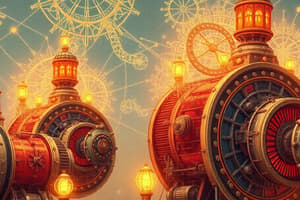Podcast
Questions and Answers
What is the primary function of an electric motor?
What is the primary function of an electric motor?
- To produce electrical energy from mechanical energy
- To control the flow of electricity
- To store energy in a battery
- To convert electrical energy into mechanical energy (correct)
Which principle does a d.c. motor operate on?
Which principle does a d.c. motor operate on?
- Fleming's right-hand rule
- The action of electric current through a conductor in a magnetic field (correct)
- Electromagnetic induction
- The generation of static electricity
What device is used to obtain the direction of force on the conductor in a d.c. motor?
What device is used to obtain the direction of force on the conductor in a d.c. motor?
- Fleming's right-hand rule
- Faraday's law of induction
- Fleming's left-hand rule (correct)
- Ohm's law
Which component of an electric motor is responsible for rotating?
Which component of an electric motor is responsible for rotating?
What connects the ends of the armature coil to the split ring commutator?
What connects the ends of the armature coil to the split ring commutator?
What are the split parts of a ring in an electric motor known as?
What are the split parts of a ring in an electric motor known as?
What role do brushes play in an electric motor?
What role do brushes play in an electric motor?
What type of source is connected to the brushes in an electric motor?
What type of source is connected to the brushes in an electric motor?
In an electric motor, what happens when the coil rotates?
In an electric motor, what happens when the coil rotates?
What configuration does the armature coil have in a d.c. motor?
What configuration does the armature coil have in a d.c. motor?
Flashcards are hidden until you start studying
Study Notes
Electric Motors
- Electric motors convert electrical energy into mechanical energy to drive devices like fans, washing machines, and kitchen appliances.
- A DC motor operates on the principle that an electric current through a conductor in a magnetic field generates a force, causing movement.
Operating Principle
- The direction of the force acting on the conductor is determined by Fleming's left-hand rule, providing guidance on force direction in electric motors.
Key Components
- Armature Coil: Wound around a soft iron core; allows rotation and is mounted on an axle.
- Split Ring Commutator: Consists of two split parts of a copper ring, enabling the direction of current to change.
- Brushes: Usually made from carbon or copper, press against the split rings for electrical connectivity.
- Horse-shoe Electromagnet: Provides a strong magnetic field essential for motor operation.
- DC Source: Typically a battery that supplies electrical power to the motor.
Motor Structure & Function
- The armature coil (ABCD) is positioned between the pole pieces of the horse-shoe electromagnet (N and S).
- The coil rotates about its axis when current flows through it, driven by the interaction with the magnetic field.
- Ends A and D of the armature coil are linked to split parts of the commutator (S1 and S2).
- Brushes B1 and B2 maintain contact with the split rings, allowing current to flow and enabling rotation.
- A rheostat and key manage current flow from the battery to control the speed of the motor.
Studying That Suits You
Use AI to generate personalized quizzes and flashcards to suit your learning preferences.




